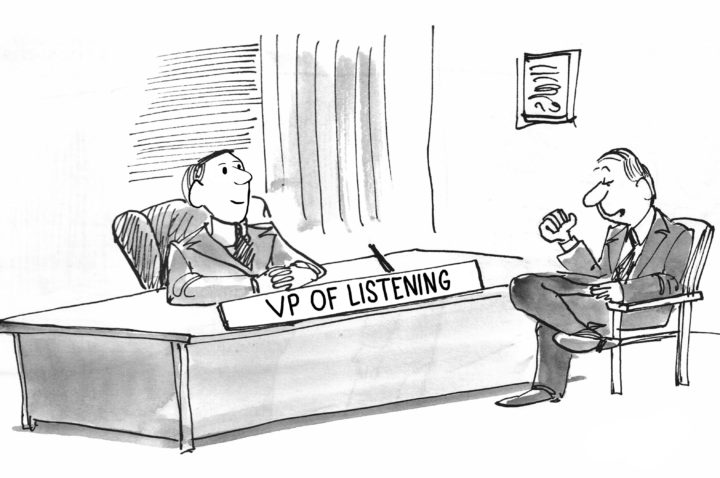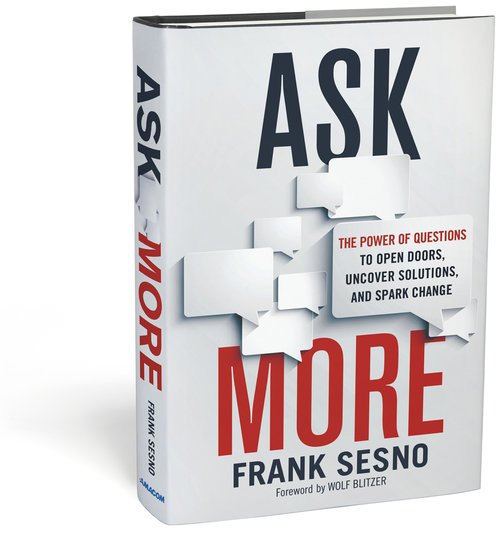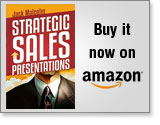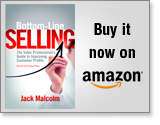I love sales questions. In my training classes, I urge B2B salespeople to ask more questions, and I teach them ways to get the buyer to open up about their problems, opportunities, challenges and risks, and to get mutually involved in devising a solution. Questions are one of the most powerful sales tools you have.
But sometimes you can fall in love with a tool and overuse it, losing effectiveness and efficiency as a result. What’s the problem with too many questions? You run the risk that the buyer may feel too “led” or even manipulated, or at least not feel like they have been listened to. And, because you are so good at using questions to uncover what you’re looking for, you may close out opportunities to discover what you’re not looking for.
The most efficient and effective sales call I ever conducted took place in a boardroom in Atlanta where I met with a company’s SVP of Worldwide Sales and several of his direct reports. I had barely set the stage with my value proposition when he cut me off: “Let me tell you what I want”, he said, and launched into a 60-minute soliloquy about his sales force and its struggle to adapt to a changing market. My participation consisted mainly of nodding, interjecting an occasional probe, and trying to take good notes. By the time he was done, George had answered every question in my sales call plan, I had checked off every one of my call actions, and we struck a deal on my largest sale to date.
If there is such a ratio as revenue per word spoken, it was easily the best sales call I’ve ever made. It flowed from start to finish, and the best part was, the sale was completely the customer’s idea! It reminded me of Napoleon’s advice to “Never interrupt the enemy when he is making a mistake”, except in this case it’s “Never interrupt the buyer when they are selling themselves.” By staying out of his way, I let George have my way.
That call was extreme, of course, but it is definitely worthwhile to strive to talk less and sell more. Good salespeople accomplish this by asking more questions; great salespeople do it by asking fewer but better questions, and by going beyond questions to achieve a similar flow.
How does achieving that flow help you sell? First, people like to talk about themselves, so once you get them started, you may create a momentum of self-disclosure which can produce broader and deeper insight into their needs. Second, people like to feel important, so by being in charge of the conversation (or at least feeling like they’re in charge) can make them feel good. Finally, when they tell you the story you want them to hear, they own it, and they’re much more likely to stick to their commitments.
How to encourage conversational flow
Conversational flow doesn’t just happen; you can stimulate your customer’s willingness to talk by what you do before and during the call.
Before the call
Avoiding too many questions during the call does not mean skipping questions altogether during your preparation. The research and planning you do will help earn the customer’s trust without which they won’t open up. Besides, it’s the only way to know if the customer’s conversation is producing the answers you need. By knowing what you need from the conversation, you will have all these mental hooks on which to organize the incoming information.
It also does not mean that you should strive for a stream-of-consciousness type of flow, in which you get the customer to talk about anything that enters their mind. The most effective sales conversations have a particular structure—even if it’s not obvious. That flow is the SCR story structure: They begin by describing their situation, bringing out their conflicts, and arriving at a resolution.
During the call
There are two general ways to encourage the customer to take control of the conversation and run with it. First, you motivate them to talk and set the frame by carefully planning your call opening, and then you use following skills to encourage and channel the flow.
The first few minutes of the sales call are crucial to achieving conversational flow. Your goal is to get the customer eager to talk about what you want them to talk about. For this, you have three tools: value proposition, action statement, and agenda.
Your value proposition and action together deliver the lean communication imperative of ATQ: Answer the Question. In every meeting, the customer/prospect wants to know: “What do you want me to do, and why should I do it?” By being very upfront about it early, you dispel suspicion and jointly agree on the reason for the meeting. In the unlikely case you’re wrong, the customer will let you know immediately and you will have an opportunity to reset or pivot as necessary.
If the value proposition and action together set the destination, your written agenda is the road map that structures the conversation. In most cases, you’re going to be very explicit, even to the point of enumerating and explaining the agenda items and offering to add any issues they might have. I would estimate that a third of the calls I go on, I rarely need to use direct questions, because the customer sees the logic of the structure and willingly participates.
Even if the customer takes control and follows their own agenda, your effort hasn’t been wasted. When George began talking, I did not interrupt him; I simply slid my agenda across the table. He absent-mindedly straightened it out in front of him and kept talking—but within a couple of minutes, it became obvious that he was glancing at it and following the points I had prepared.
As the customer talks, your principal task is to listen intently and stay out of the buyer’s way if they’re following the right path, or nudge and gently re-direct them when they’re veering off. You can use encourages, probes and reflections, all fundamental following skills which you can brush up on here, or if you’re not already familiar with, you can pick up with a book or a class on active listening.
The hardest thing to do, especially when the customer is talking non-stop, is to keep the incoming information organized enough to know whether you’re getting what you need to accomplish your call purpose. That’s where your sales call plan with its prepared question list comes in handy, to help you unobtrusively check off which have been answered. I’ve also found the Cornell note-taking system to be enormously useful for maintaining situational awareness, and for recording keywords that will allow you to go back and revisit areas that need more attention.
Candidly, most salespeople aren’t ready for the ideas in this article, because they still haven’t learned how to ask enough good questions. But if you’ve already reached this stage, you can kick up your skills one more notch by learning how to go beyond questions.
If you could think of one change to make in your communication habits that would make you more influential, more interesting, and more well-liked, what would it be? The answer, according to Frank Sesno—and one which I strongly endorse—is to ask more questions. In his book, Ask More: The Power of Questions to Open Doors, Uncover Solutions and Spark Change, Sesno, a former CNN anchor, explains why questions are so powerful and how to ask them.
In this review, I will ask and answer four questions:
- Why should you ask more questions?
- Why read this book?
- What are some of the main lessons?
- How should you read the book?
Why ask more questions?
You probably don’t ask enough questions—so what? The big-picture answer, filtered through the lens of lean communication, is that you are producing less value and more waste than you should. Value is defined by the listener, and if you don’t know your listeners as well as you should, how can you express your points in ways that are most likely to resonate with them? Asking more questions helps you zero in on exactly what’s important to the other person. But even better, asking questions engages the other person so that together you both create more value and more memorable communication. I love this quote from the book: “People forget what they heard, but they remember almost everything they say.”
Why read this book?
There are many good books on questioning, written from the perspective of sales, psychology, management[1], etc. but this is the first one (that I’ve read, at least) by a journalist, who by definition makes his living through the quality of his questions. Besides the credibility it adds to the book, Sesno’s professional expertise adds two other assets that make Ask More worth reading. First, he knows how to find other credible sources, so he is not just relying on what has worked for him, as so many experts do, and this brings a breadth and diversity of different situations and applications where questioning is helpful. of questioning applications. Second, he knows how to tell stories lucidly and concisely, so the book makes for pleasant and engaging reading.
What are some of the main lessons?
The book is organized into chapters that explain how to ask questions for different purposes, from solving problems to inspiring others, to sparking creative thinking, to building rapport. But regardless of your purpose in asking questions, some general principles come through. Probably the most important is that you should have a purpose and a plan for your questions. Your plan will help ensure that you don’t miss anything important, and your purpose will keep you on track when the person you’re interviewing inevitably throws you off your plan, whether accidentally or on purpose. Second is the importance of knowing how to listen to the answers and what to listen for—especially what is not being said. Third, by learning the basic structure of each specific questioning application, you can apply a reasonably repeatable process that will save you time and ensure you don’t miss anything.
How should you read the book?
If there is one improvement opportunity I would suggest for this book, it would be to go a bit lighter on the stories and heavier on the “how-to”. For example, in the chapter on empathetic questioning, as he introduces a man who got John Hinckley to open up through questions, do we really need to know the path of each of the six bullets John Hinckley fired? That’s why I would suggest that you begin reading the book at page 211, which begins the “Question Guide” section, where the basics of each major questioning task are laid out. Then, you can go back through the book and read the sections that you find most useful, and having the layout of each section in mind will make it easier to tease out the lessons from the stories and extraneous detail.
Despite that last quibble, Ask More is an important and worthwhile book. We can all benefit from improving the quantity and quality of the questions we ask, and I personally resolve to improve on that this year. So, let me end with one more question:
What are you waiting for?
[1] A few good examples: SPIN Selling and Question Based Selling for Sales; Leading with Questions, for leadership;
Humble Inquiry, for psychology.
In Part 1, we posed the problem of providing help to clients in such a way that they actually find it helpful, so that they act on the advice given. To do so requires that we establish a climate of equal status between the salesperson and the client, generate a sufficient level of trust, and ensure that the client takes ownership of the solution. That, in turn, requires a questioning process called humble inquiry, which Schein elaborates on in his book, Humble Inquiry: The Gentle Art of Asking Instead of Telling (BK Business).[1]
As Schein defines it, “Humble inquiry is the fine art of drawing someone out, of asking questions to which you do not already know the answer, of building a relationship based on curiosity and interest in the other person.”
How does this differ from the typical form of questioning used in sales? First, let’s assume that the salesperson actually asks questions and listens to the answers, which is definitely not a given.
Assuming that the salesperson goes so far as to ask questions, the typical approach is to ask a few qualifying questions up front, identify problems/opportunities that fit with their advantages, possibly diagnose why the problems exist, and then provide insights in the form of solutions. Or, they can work through a specific methodology such as SPIN. There are two common threads in all these questioning approaches: first, the salesperson asks them with a specific goal in mind, and, second, it’s important to keep control of the conversation.
That’s why salespeople are often told not to ask a questions to which they already know the answer, as if they are cross-examiners in a criminal trial. In this way, they can keep control of the direction of the conversation, which puts them in a “one-up” position.
But what if being in control interferes with a trusting climate, or prevents the client from saying something that may actually shed better light on the situation? In that case, the salesperson may solve the wrong problem, or solve the right problem before the client is ready to act on the solution.
Notice the stark difference between directed questioning approaches and humble inquiry, which requires that the questioner “access their ignorance” and sincerely ask the most open-ended of questions, those which may totally surprise them with the answers given.
Humble inquiry begins with open inquiry, which is simply gaining a sufficient understanding of the client’s situation, without an agenda. Your goal here is to ask and listen, without judging or formulating responses. This is important for two reasons. First, being too highly focused on what you want to find out can easily obscure important information which may be necessary to uncover and solve the real problem at hand. Second, it impairs the development of trust, because the client senses your agenda and is on guard for the other shoe to drop.
How to use humble inquiry in sales conversations
Schein does not address sales situations specifically, so the rest of this article represents my own thinking on how humble inquiry can be used during a sales conversation.
First, should you even use it? If so, when is it appropriate, and how should it be used?
Your ultimate goal is to make a sale, so why not proceed directly on the path that will take you there, instead of wasting time in aimless conversation? It seems like poor use of the precious time you actually have with them. The second concern is that no salesperson likes to lose control of the conversation, and it’s easy to think that listening without an agenda is a form of unilateral disarmament which will lessen your chances of making a sale.
The answer to the first concern is that except for automated computer trading algorithms, no purchasing decision is based entirely on 100% logical, quantifiable reasoning. The person sitting across from you is a real human being with real – and unique – human needs, feelings, quirks, and aspirations, and they like to feel important and valued. One of the best ways they do is to have others actually take an interest in them. That good feeling may make a difference in the immediate sale, and be a basis for a fruitful long-term relationship.
As to losing control, that could happen if humble inquiry were the only tool you had to bring to the conversation. But, just because you start with it does not mean that you can’t switch to your other questioning approaches at the appropriate moment – in fact you will have to switch at some point. When you feel the discussion has arrived at the right point, you can phase into your diagnostic and expert roles.
Another approach is to listen carefully to the client and then use what Schein calls “constructive opportunism”, which is your ability to recognize conversational openings that you can jump into, to explore something further, or probe to uncover additional needs. Based on your expert knowledge of how your product or service addresses typical customer needs, you will probably hear plenty of keywords that indicate POCR: problems, opportunities, changes and risks. The benefits of this are that it’s less disruptive to the natural flow of the conversation, and the issues that emerge are the client’s own ideas.
Keep in mind that if you decide to try humble inquiry in your sales conversations, it will not be easy, as I’ve been discovering. You will have to overcome habit, culture and human nature. Our sales habits lead us to pounce on perceived needs; our culture values doing and telling; and our natural human instinct is to claim higher status that comes from showing how smart we are. But if you can persevere through the difficulties, you stand a better chance of providing help that is truly helpful, and isn’t that worth the effort?
[1] Part 1 was based on Schein’s first book, Helping. That book also explains the humble inquiry approach. Unless you really want to dig deeply in to the topic, you don’t have to read both books. I would recommend Helping if you only want to read one.
In a class I ran last week, the participants seemed to be having a harder time than usual asking their customers (actually, their colleagues playing the part of customers in role plays) the hard questions. They would ask one or two questions about the customer’s situation, and then fail to probe when the customer’s answer hinted that things may not be as rosy as they claimed. Words like, “issues, struggles, lack of, etc.” zipped unnoticed over their heads like stealth planes.
Instead, the salespeople would listen intently, maybe jot down a note or two, and then when the customer finished their silent pleas for help, launch into their canned pitch about all their “solutions”.
When I tried to figure out what was going on, one of the students told me that they have been conditioned to accentuate the positive, so it seems like a downer to get the customer talking about the problems in their situations. I replied that if doctors acted that way, no one would ever be cured of anything.
Why do so many sales conversations avoid these areas? I don’t know for sure, but I can speculate. It may be a sense that the customer already knows what he needs, so you sound pushy in bringing it out. It could be a lack of knowledge of the customer’s industry, company, or operations. It might even be impatience to talk about the wonderful slick product you have. But mostly I think it’s the fear of upsetting the customer by bringing out unpleasant topics.
The problem with that, is that status quo is extremely powerful. Customers will never buy except to solve a problem, take advantage of an opportunity, adapt to change or mitigate a risk. And even if those are present in their situation, if they don’t talk about them they may be able to fool themselves that they can put off doing something about them. Meanwhile, the consequences and risks pile up because no one has asked the hard questions.
They can only put off action for so long before eventually the need catches up with them, but by then you probably won’t be there to help. The only person who wins when you steer clear of the hard questions is your competitor.





